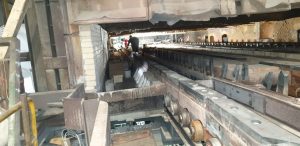In complex industrial machinery, refractory linings stand as silent guards, protecting critical equipment and processes in a wide variety of sectors. In this extensive review, we will explore the specific application of these coatings in industry, highlighting their vital role.
Coatings in different types of industry
Metallurgy
In the smelting furnace of metallurgy, refractory linings are shields against scorching temperatures. Their ability to withstand extreme conditions ensures the integrity of the furnace, enabling efficient and prolonged metallurgical processes.
Steelmaking
In steelmaking, refractory linings become guardians against wear and corrosion. Protecting converters and furnaces, these linings ensure the continuity of steel production by resisting the adversities of slag and high temperatures.
Glass Industry
In glass manufacturing, thermal precision is essential. Refractory linings in melting furnaces enable stable thermal conditions, facilitating the efficient and sustainable production of high quality glass products.
Petrochemical Industry
The corrosive environments and high temperatures of the petrochemical industry demand robust refractory linings. Protecting reactors and boilers, these linings offer chemical and thermal resistance, ensuring safety and efficiency in the production of high quality glass products.
Other applications
- Energy on the Rise: In power generation, refractory linings play a crucial role. By protecting boilers and combustion systems, they contribute to efficiency in electricity production and are pillars in the quest for energy sustainability.
- Strength in Cement and Ceramics: Cement and ceramics production imposes extreme challenges on equipment. Refractory linings resist abrasion and high temperatures, ensuring consistent and reliable production of crucial materials in construction and manufacturing.
- Automotive in the Heat Treatment Furnace: In the automotive industry, refractory linings find their application in furnaces and heat treatment systems. They contribute to the quality and strength of parts, playing an essential role in the production of durable and safe automotive components.
What about the future?
The use of refractory coatings is evolving with technological advances. The application of new formulations and materials aims to improve thermal resistance and durability, meeting environmental challenges and increasing efficiency in various industries. Research and development in refractory linings continues to advance, exploring new compositions and techniques to further improve their performance. Innovation is geared towards creating coatings that are stronger, more durable and tailored to specific challenges.
Operational efficiency is a key pillar in industry, and refractory linings contribute significantly to this. By protecting key equipment, these linings ensure greater durability and reduced maintenance requirements, optimising processes and reducing long-term costs. Sustainability emerges as a key factor in the application of refractory linings. The industry is looking for more environmentally friendly formulas and processes, integrating practices that reduce the ecological footprint of these essential materials for industrial infrastructure.
In conclusion, refractory linings are not simply protective coatings; they are critical shields in industrial machinery. From metallurgy to energy, their specific application highlights their essential contribution in preserving and improving crucial processes in industry.
Performance in industry
The application of refractory linings in harsh environments highlights their ability to withstand extreme conditions. Whether in high temperatures, corrosive environments or in the presence of aggressive chemicals, these coatings demonstrate their versatility and strength.
It also involves a long-term cost assessment. While the initial investment may be significant, the return comes in the form of increased durability, efficiency and reduced maintenance costs, positioning these coatings as strategic investments for the industry.
The specific application of refractory linings will continue to evolve as technology, sustainability and industrial demands change. With a focus on continuous improvement and adaptation to changing needs, these coatings will play a crucial role in the industrial infrastructure of the future.
Conclusiones
La aplicación específica de revestimientos refractarios en la industria es una narrativa en constante evolución. Más allá de su función básica de protección, estos componentes se perfilan como protagonistas clave en la transformación industrial. Su influencia se extiende desde la fundición en altos hornos hasta la exploración del espacio, y su capacidad para adaptarse y evolucionar promete un papel aún más central en el tejido industrial del futuro.
En última instancia, los revestimientos refractarios encarnan la dualidad de ser guardianes silenciosos y motores de innovación. Su aplicación específica, a medida que enfrenta desafíos cambiantes y abraza avances tecnológicos, demuestra que su importancia va más allá de lo evidente. En el lienzo industrial, estos revestimientos pintan una historia de resiliencia, adaptabilidad y contribución constante al progreso.




